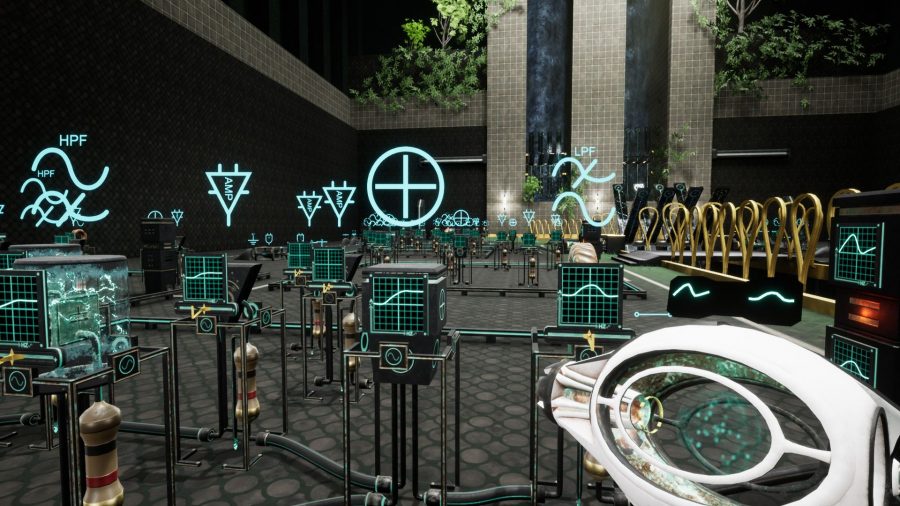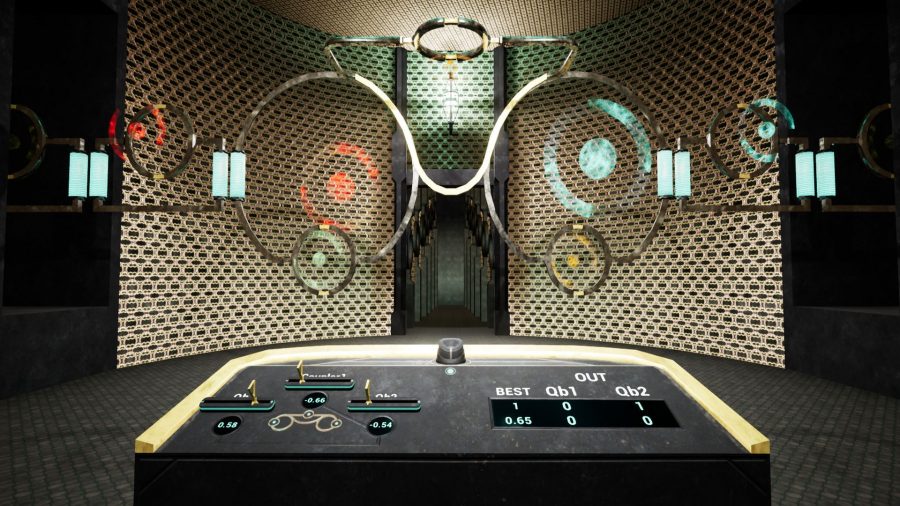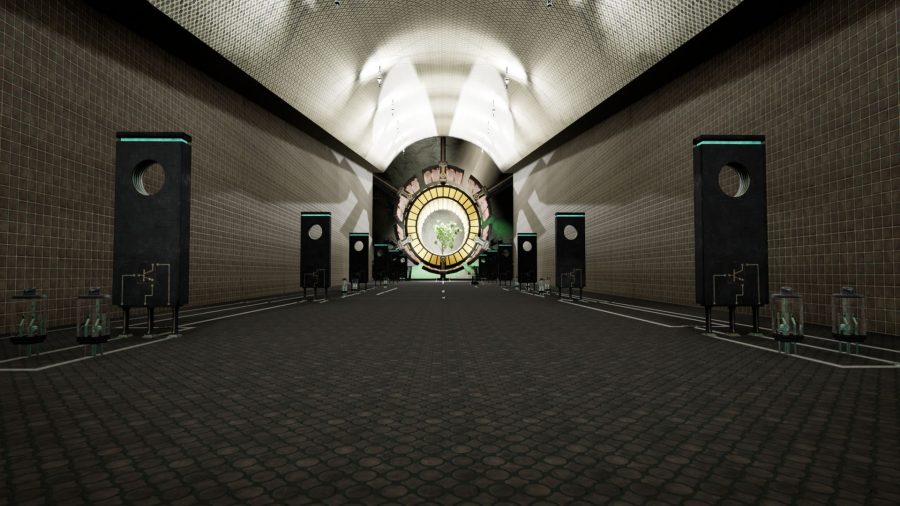Quantum mechanics is one of those scientific fields that seems to transcend its own impenetrability. It captures the imagination of us all, even if we don’t quite understand the ins-and-outs of what often sounds just as much like magic as it does science. While science fiction games like Bioshock: Infinite offered a pulpy, pop take on its principles, it’s rare to see a game that weaves these ideas into its very systems. Enter the physics-based circuitry puzzles of The Long Gate.
The Long Gate has been referred to as a ‘Zachlike’, a genre named after the engineering puzzle games of Zachtronics founder Zach Barth, such as Infinifactory and Opus Magnum. Where those games are largely abstract, The Long Gate is immersive, giving the player beautiful first-person environments to explore while they solve puzzles involving accurate depictions of quantum circuits and computation, verified by scientists at quantum computing company D-Wave Systems.
To celebrate The Long Gate’s release last week, we spoke to lead designer David Shaw about the unique design challenges his project presents, and why Unreal Engine 4 was the (Schrödinger’s) cat’s whiskers when it came tackling them. Or, if you’re reading this through the lens of Quantum Mechanics, we both did and didn’t, and are still going to speak to Shaw at some point in the future.
Shaw’s background is in electrical engineering, and it’s this expertise that informed and inspired The Long Gate’s design.

“I believe a lot of circuits have great potential to be the basis of rewarding puzzles,” says Shaw. “Small components that follow rules – as simple as output is opposite input – can be combined in countless creative ways that build on one another to make things as complex as the computers we use every day. I also like the idea of being able to teach people something that doesn’t only exist within a videogame, without them even realising it.”
With quantum computers existing in both positive and negative states simultaneously – “a state of superposition,” Shaw says – how was he able to create puzzles based on them?
“A realisation that made understanding quantum computers much easier for me was that saying it is ‘in both a positive and negative state at once’ is functionally the same as saying it’s still computing, or that we haven’t checked the output yet. When we measure a qubit it will always have a value of one or zero, so it’s the same principle as Schrödinger’s cat – we simply don’t know the result until we open the box.”
In the type of quantum circuits shown in The Long Gate, Shaw says, the programmers – or in this case, players – set up “electrical currents to influence the relationships between qubits, then the qubits are put in a state of superposition where a new current is slowly turned up, until the currents flowing in and between the qubits become stable. Then we measure the output as ones or zeroes.”
“Of course,” Shaw adds, “my quantum puzzles are never in a real state of superposition or exhibiting other quantum properties because they’re running on a digital computer, but I worked with scientists at D-Wave Systems to make sure I was portraying the quantum circuits accurately, both in terms of visuals and the maths running behind the scenes.”
Read more: Check out the best adventure games on PC
If this sounds like a level of complexity that would be formidable to all but the most dedicated puzzle fans, don’t worry. Although Shaw admits that The Long Gate “might seem a little daunting at first,” the game introduces its systems gradually by putting tutorials upfront. Just don’t sprint through them without getting acquainted, Shaw says. “My advice for approaching most of the puzzles is to find the starting point or power source for each circuit and then take things one step at a time to get the power to flow to the output.”
It’s also a testament to the logical granularity of the design that the puzzles aren’t just constrained to single, static solutions. “Keep in mind that some puzzles can be solved in more than one way,” says Shaw. “There are also optional hints that most players will find helpful.”
To make The Long Gate stand out from the first-person puzzler crowd, Shaw’s goal was to create a visually striking environment in which players could find solace while they solved its unique puzzles. There’s a retro-futuristic feel to things, all tangible circuitry and Vernian physicality, made tranquil, almost ethereal, by its plant life and open, bright spaces.
“Atmosphere was very important to me,” Shaw says. “in creating each of the levels my first thought and guiding design principle was how my eyes were going to be drawn inward and (usually) upwards through the levels from the player’s viewpoint and then move across the screen, not unlike how the composition of a painting will move your eyes to a focal point.” Vastness. Mystery. A sense of wonder.
This focus on perfecting the environmental atmosphere, says Shaw, is what led him toward Unreal Engine 4.
“It’s a great game engine for making beautiful environments. As a beginner, the lighting system, blueprints scripting, the material editor, and the foliage systems were all easy to get a hang of. Affordability and accessibility were also extremely valuable to me as an independent developer. Especially when I was just getting started, Unreal’s educational YouTube videos and online documentation were invaluable.”
Creating puzzles based on the interactions between moveable circuits presented another hurdle to overcome.
“Getting all the moveable circuit components to work right without crashing the game was a challenge for me,” Shaw says, citing the complexity of dealing with such a major component in The Long Gate’s puzzles. “But it was easy to fix and move forward once the causes were identified”. Designing the quantum puzzles, Shaw adds, was also a challenge, “but implementing them in Unreal it wasn’t hard, and I even did so entirely with blueprints.”
Related: Check out the best indie games on PC in 2020
“Unreal Engine made a lot of things easier than I think they would have been if I used a different engine. Blueprints scripting was a huge asset for me, and Unreal also has some great tools for debugging and profiling games so that they run smoothly. It was also extremely easy to set up scalability setting so that my game can run on a wider variety of computers. Setting up sound effects and mixes was also a breeze in Unreal”.
The Long Gate is out now – check out the Steam page for more information. Unreal Engine 4 is now free. Unreal Engine 5 is due to release next year.
In this sponsored series, we’re looking at how game developers are taking advantage of Unreal Engine 4 to create a new generation of PC games. With thanks to Epic Games and David Shaw.




